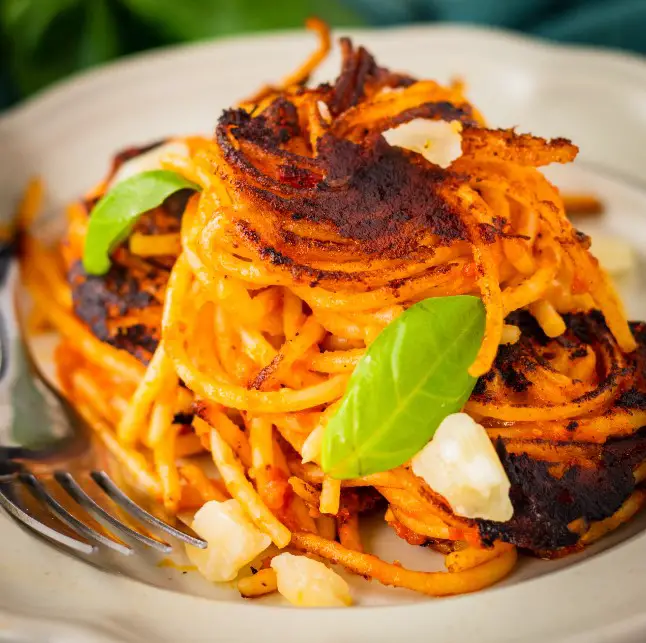Introduction to Fried Spaghetti
Fried spaghetti, a dish that intertwines the simplicity of pasta with a unique cooking technique, has emerged as a beloved variant in the world of culinary delights. Its history, while not as documented as traditional pasta dishes, is rooted in the innovative spirit of home cooks and professional chefs alike, who sought to transform leftover spaghetti into something extraordinary. This dish has gained popularity for its delightful texture – a crispy exterior with a tender, flavorful interior.
The variations of fried spaghetti are as diverse as its fans. From the classic, cheese-laden Italian version to the incorporation of diverse ingredients like meats, vegetables, and spices, this dish transcends cultural boundaries. Some prefer a vegetarian twist, incorporating a medley of garden-fresh produce, while others opt for heartier versions, adding meats such as chicken, beef, or even seafood. The spicy rendition, a favorite for those who enjoy a kick, often includes chili flakes or hot sauces. Each style offers a unique taste experience, making fried spaghetti a versatile dish that caters to a wide range of palates.
Ingredients and Variations
The allure of fried spaghetti lies in its simplicity and the versatility of its ingredients. At its core, the dish consists of a few key components that, when combined, create a symphony of flavors and textures.
Common Ingredients in Fried Spaghetti Recipes:
-
- Pasta: Spaghetti is the traditional choice, offering the perfect balance of surface area and thickness to achieve that coveted crispy exterior.
- Oil: Olive oil is a popular choice for frying, adding a subtle flavor while allowing the spaghetti to crisp up beautifully.
- Cheese: Parmesan or mozzarella are often used to add a creamy, rich layer to the dish.
- Seasonings: Simple seasonings like salt, pepper, garlic, and herbs like basil or parsley enhance the natural flavors of the ingredients.
Variations:
-
- Vegetarian Versions: These often include a variety of vegetables like bell peppers, onions, mushrooms, and spinach. For those seeking a vegan option, dairy-free cheese substitutes and plant-based meats can transform the dish into a vegan delight. For inspiration, check out The Fiery Vegetarian’s Easy Fried Spaghetti Recipe.
- Meat-Based Variations: Common additions include ground beef, chicken, bacon, or even seafood, turning the dish into a hearty meal. The meat is usually sautéed or cooked separately before being mixed with the spaghetti.
- Spicy Versions: To add heat, ingredients like chili flakes, cayenne pepper, or even hot sauce can be incorporated. This version is perfect for those who enjoy a fiery twist to their meals.
Substitutes and Alternative Ingredients:
-
- For a gluten-free option, spaghetti can be replaced with gluten-free pasta varieties.
- In place of olive oil, other cooking oils like avocado or vegetable oil can be used.
- For a healthier take, whole wheat spaghetti offers more fiber, and low-fat cheeses can reduce the calorie count.
Each variation of fried spaghetti not only caters to different dietary preferences and restrictions but also opens up a world of culinary creativity, allowing both home cooks and chefs to experiment and put their unique spin on this classic dish.
Advanced Cooking Tips for Fried Spaghetti
Elevating your fried spaghetti to a gourmet level involves more than just mastering the basic cooking techniques. It’s about enhancing flavors, making thoughtful pairings with sides and wines, and presenting the dish creatively.
Enhancing Flavors:
-
- Infuse the Oil: Start by infusing the frying oil with garlic, chili flakes, or herbs like rosemary or thyme. This adds a depth of flavor to the oil, which in turn flavors the spaghetti.
- Use Quality Ingredients: Opt for high-quality pasta and fresh, organic vegetables. The better the ingredients, the better the final dish will taste.
- Layer Flavors: Incorporate umami elements like sautéed mushrooms, caramelized onions, or sun-dried tomatoes. These ingredients add a rich, savory depth.
- Finish with Freshness: Before serving, add a sprinkle of fresh herbs, a squeeze of lemon, or a drizzle of high-quality extra virgin olive oil for a fresh, bright finish.
Pairing with Sides :
-
- Sides: Complement fried spaghetti with sides that offer a contrast in texture and flavor. A crisp green salad, steamed vegetables, or garlic bread make excellent choices.
Creative Presentation Ideas for Fried Spaghetti:
-
- Individual Servings: Serve the spaghetti in mini cast-iron skillets or ramekins for a personalized touch.
- Garnish Wisely: Use garnishes not just for color but also for flavor. Edible flowers, microgreens, or a sprinkle of edible gold dust can elevate the presentation.
- Plate with Purpose: Consider the plate as a canvas. Use sauces or infused oils to create a design on the plate before adding the spaghetti.
- Height and Texture: Build height in your presentation for a more dramatic effect. Layer the spaghetti with other ingredients or use culinary rings to shape the pasta.
By incorporating these advanced cooking tips, your fried spaghetti will not only taste incredible but also look like a dish straight out of a gourmet kitchen.
Health and Nutrition for Fried Spaghetti
While fried spaghetti is often indulged as a comfort food, understanding its nutritional aspects and how to adapt it for healthier versions is essential for those mindful of their diet.
- Nutritional Breakdown:
- Traditional fried spaghetti is typically high in carbohydrates and fats, primarily due to the pasta and frying oil. The cheese adds a significant amount of saturated fats and calories, while the dish can also be a good source of protein, especially when meat is included.
- It’s important to note that this dish can be high in sodium, depending on the cheese and added seasonings.
- Making Healthier Versions of Fried Spaghetti:
- Opt for Whole Grains: Substitute regular pasta with whole wheat or other whole-grain varieties to increase fiber content.
- Reduce Oil Usage: Minimize the amount of oil used for frying, or consider using a cooking spray to reduce fat content.
- Incorporate Vegetables: Add a variety of vegetables like spinach, zucchini, or bell peppers to increase the dish’s vitamin, mineral, and fiber content.
- Choose Lean Proteins: Incorporate lean meats like chicken breast or turkey, or use plant-based proteins for a healthier twist.
- Dietary Considerations:
- For gluten-free diets, use gluten-free pasta options.
- Vegan and vegetarian versions can be easily achieved by omitting meat and using plant-based cheese alternatives.
- To reduce sodium intake, limit added salt and choose low-sodium cheese and sauces.
Consider these health and nutrition aspects to adapt fried spaghetti to fit your dietary needs and preferences, enjoying this versatile dish in a healthier way.
FAQs
Let’s explore some common questions about fried spaghetti:
- How to Cook Spaghetti in a Frying Pan?
- Boil the spaghetti until al dente, then fry in a pan with a bit of oil.
- Can You Fry Pasta in Oil?
- Yes, frying pasta in oil gives it a crispy texture.
- Storage and Reheating Instructions:
- Store in an airtight container in the fridge for up to 5 days.
- Reheat on the stovetop or in the microwave.
Conclusion
In summary, fried spaghetti is a delightful culinary creation that combines traditional pasta with a unique twist. Its versatility in ingredients and variations caters to a wide range of tastes, from vegetarian to meaty and spicy options. The cooking techniques, involving frying and baking, are crucial for achieving the perfect crispy yet tender texture. Consider health and nutrition aspects to adapt this dish to various dietary needs. We encourage you to explore the world of fried spaghetti, experiment with different flavors and ingredients, and discover your own favorite version of this classic, reimagined dish.
For more culinary adventures and unique twists on classic dishes, explore kitchenflavors.net, where you can find a variety of recipes like Haitian Spaghetti that offer a culinary journey through Caribbean flavors.


